This homemade soy sauce chicken has silky tender meat with a deep savory flavor. Learn how easy it is to make this Cantonese dim sum at home and even achieve restaurant taste. {Gluten-Free adaptable}
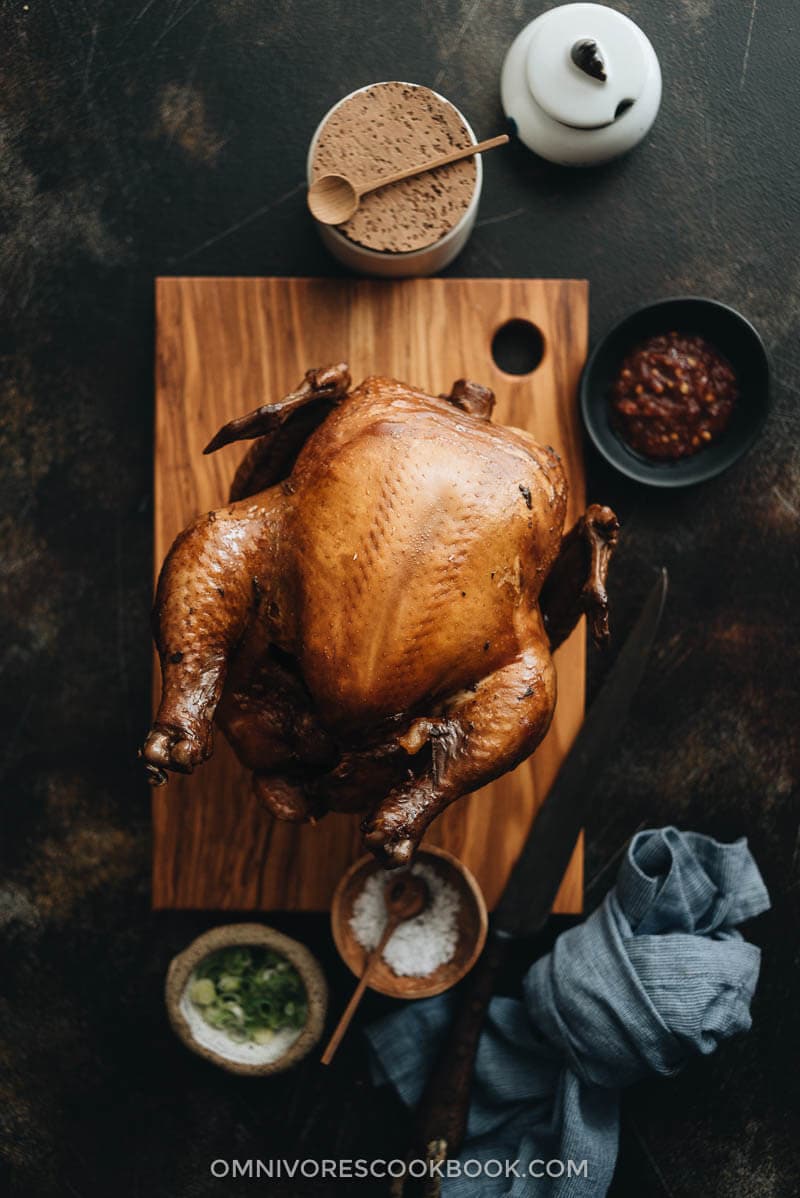
Cold sliced soy sauce chicken is definitely a Chinese dim sum classic. Along with crispy duck, char siu BBQ pork, and crispy pork belly, it’s one of those dishes that we order most often whenever we visit a Cantonese dim sum restaurant.
Dealing with a whole chicken might seem like a daunting task. But once you try the recipe, you’ll find out it’s quite straightforward. All you need to do is to mix the marinade, soak the chicken overnight, then simmer until the chicken is just cooked.
The finished chicken has such a tender, silky texture and a deep savory taste with a hint of sweetness. Served with hot steamed rice and extra sauce, I can’t stop eating even when I’m full!
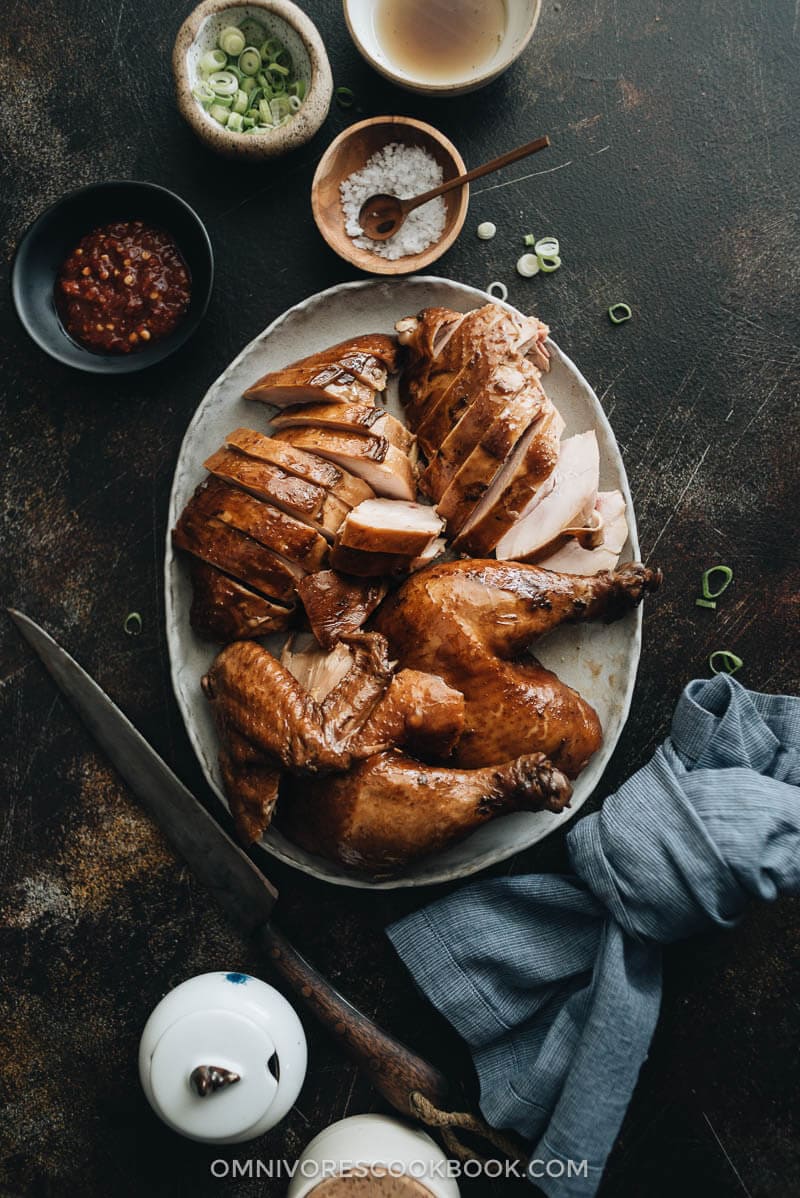
How to make the best soy sauce chicken
1. How to choose the right chicken
If you ask any Chinese chef, they’ll always recommend a young cage-free chicken that weighs less than 2 pounds. Because the smaller the chicken, the more the seasonings penetrate and the tenderer it will taste after simmering. That’s why if you browse a Chinese recipe site, most recipes won’t suggest marinating the chicken beforehand and include merely 15 minutes to cook the whole bird through!
In reality, it’s not that easy to find a chicken of such small size in the US. Plus, I prefer to cook some more meat to have some leftovers, since it takes quite some time to prep all the seasonings.
I prefer to use a smaller sized chicken, one that weighs 3 to 4 pounds. You can use a bigger bird as well. But note, it will take longer to cook through and it might not taste as tender.
2. Marinating is a must
Like I just mentioned above, many Chinese recipes do not include a marinating process, or they utilize a very brief marinating time. When dealing with larger chickens, marinating overnight is highly recommended, so your chicken will end up super flavorful.
The marinade ingredient list might look long, but you can probably find most, if not all, of them already sitting in your kitchen cupboard.

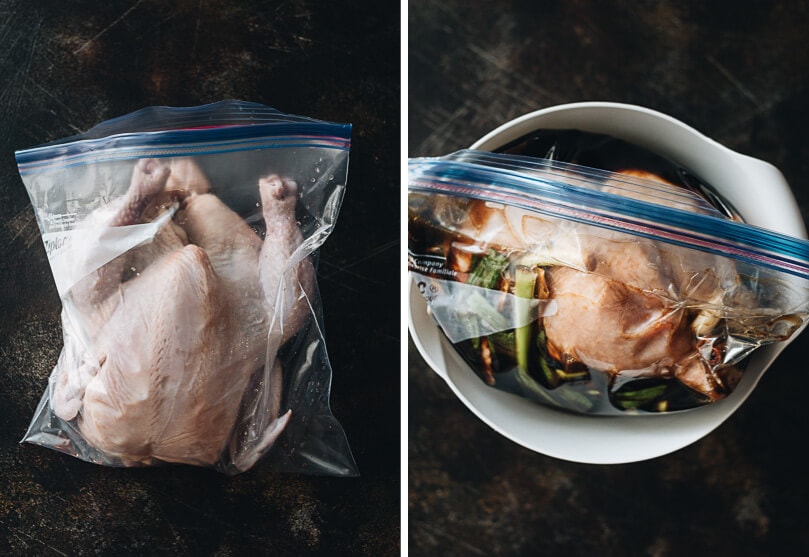
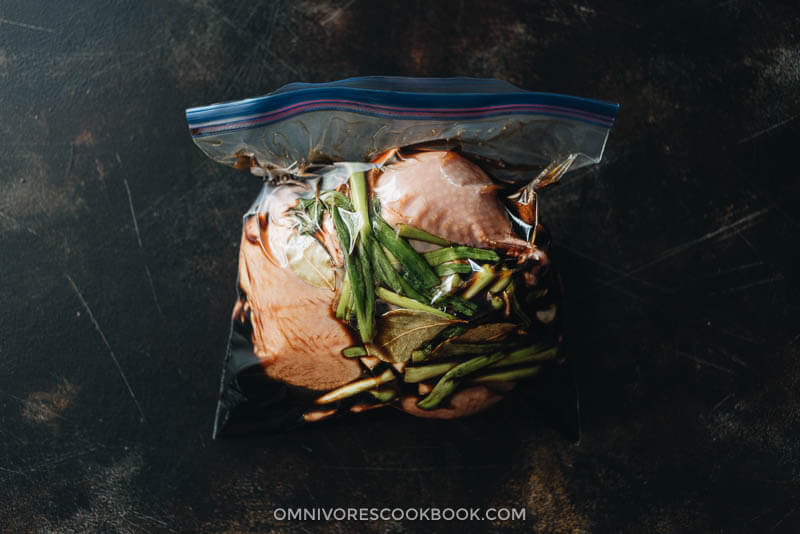
3. Choose the right pot
You should use a small, tall pot that is just wide enough to hold the chicken and can hold all the liquid. I often use a tall saucepan.
If you have to use a bigger pot, you’ll need to add enough water so at least half of the chicken is covered. In this case, place the chicken breast-side-down at first. Cook 15 minutes and then flip it so the chicken breast faces up.
4. Simmer, gently
The only time you should bring the broth to a boil is at the very beginning. Then you should always keep the broth at a simmer, where there are small bubbles raising to the top of the broth here and there. The very gentle simmer will produce buttery tender chicken without overcooking it. After 20 minutes, I’ll turn off heat and let the pot sit on the hot stove for another 30 minutes, so the chicken will be just fully cooked.
Deciding the right cooking time is tricky, since it can vary a lot depending on the size of the chicken and the type of stove you use. Just keep in mind that you should always keep the simmering very gentle, and check on the chicken every 15 to 20 minutes. You should cook until the thickest part of the thigh is just cooked through, to yield the best texture.
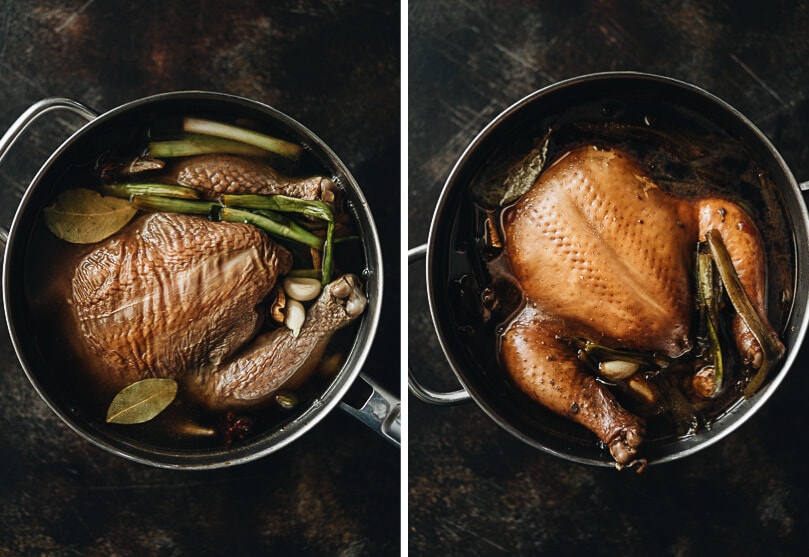
5. Slice and serve
Chinese restaurants always use a cleaver to chop the chicken into pieces and serve it bone-in. To make it easier for home cooks, I chose to carve it using a chef’s knife. I would carve the chicken into legs, breasts and wings. Then I’ll slice the parts I plan to serve and save the rest in a container.
The chicken tastes great warm and cold. I always reserve some braising liquid as dipping sauce and pour some on the steamed rice. You can also serve it with some Sriracha sauce.
If you don’t like the texture of the soft chicken skin, you can crisp up the skin under the broiler. But to speak the truth, I never feel like I need that extra step, despite the fact that I LOVE crispy chicken skin. The soy sauce chicken tastes perfect the way it is 🙂
I hope you enjoy the dish as much as I do!
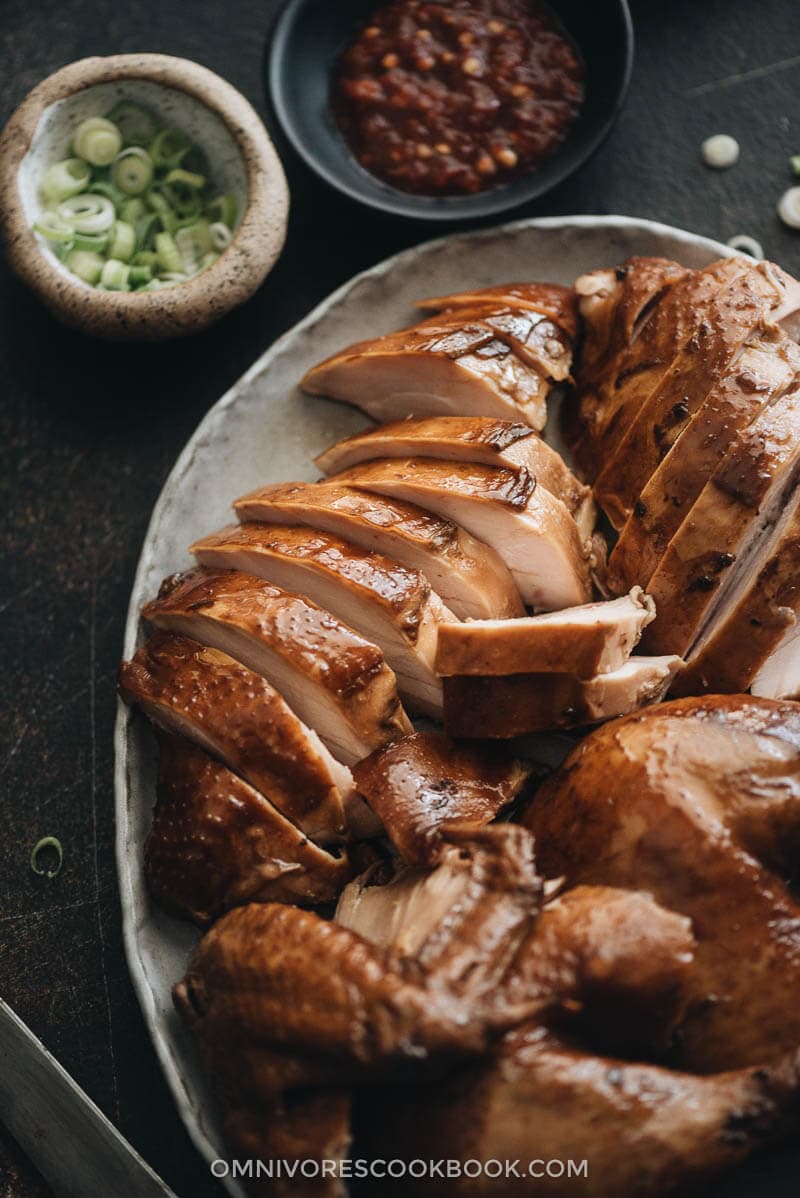
More delicious dim sum dishes
- Char Siu BBQ Pork
- Crispy Pork Belly
- Pork and Shrimp Shumai
- Steamed Ribs in Black Bean Sauce
- Cantonese Wonton Noodle Soup
- Chinese Broccoli with Oyster Sauce
If you give this recipe a try, let us know! Leave a comment, rate it (once you’ve tried it), and take a picture and tag it @omnivorescookbook on Instagram! I’d love to see what you come up with.
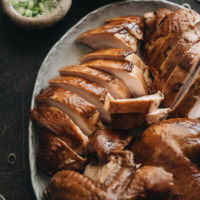
Real-Deal Soy Sauce Chicken (豉油鸡, See Yao Gai)
Ingredients
- 1 4 lbs / 1.8 kg whole chicken
Marinade
- 2 cups soy sauce
- 2 tablespoons dark soy sauce (Optional)
- 1/2 cup Shaoxing wine (or dry sherry)
- 2 tablespoons sesame oil
- 1 cup brown sugar (or granulated sugar)
- 1 big thumb ginger , coarsely chopped
- 8 cloves garlic , smashed
- 6 green onions
- 3 bay leaves
- 1 star anise pod
- 1 small cinnamon stick
- 1/2 teaspoon fennel seeds
- 2 cloves
Instructions
- Combine all the marinade ingredients in a medium-sized saucepan. Bring to a simmer. Stir and cook until the sugar dissolves. Set aside to cool.
- Place the chicken in a gallon-size ziplock bag. Carefully pour the cooled marinade mixture into the bag with all the ingredients. Seal the bag and squeeze out as much as air possible. Massage the bag a few times to evenly distribute the marinade. Place the bag in a large deep bowl so it “pushes” the marinade to fully cover the chicken. Plus the marinade won’t cause a mess if your bag accidently leaks. You can marinate the chicken in a large bowl, too. In this case, you might need to flip the chicken 2 to 3 times during the marinating process. Cover with a plastic bag if using a bowl. Let marinate overnight.
- Chose a pot that is deep and just wide enough to hold the chicken. Add the chicken into the pot, breast-side-up. Pour in all the marinade with the ingredients. If the chicken is not covered, add up to 4 cups water. It’s OK if a small part of the chicken breast is not covered in the liquid.
- Bring to a boil over medium high heat. Turn to medium-low or low heat. Use a fine mesh strainer to skim the foam and discard. When the broth reduces to a simmer, cover the pot. Simmer for 25 minutes. Turn off the heat. Let the chicken sit in the hot broth, covered, for another 30 minutes, or until the chicken is just cooked. To test, you can either insert a thermometer into the thickest part of the thigh or slice the skin that attaches the thigh to the body: the root of the thigh should no longer be pink. Soak the chicken in the broth, covered, if the chicken is not cooked. If the chicken is still very raw, return the pot to a simmer and cook until the chicken is fully cooked.
- Once done, carefully transfer the chicken onto a big plate and drain all the liquid from the cavity. I usually do this wearing one oven mitt with a few layers of paper towel, with the other hand using a pair of tongs. Let the chicken cool enough to handle with your hands. Carve the chicken and slice the parts you plan to serve. Reserve the liquid to use as dipping sauce, or for braising (try using it to braise daikon radish or potato - so delicious!).
- Serve the chicken warm with rice as a main or as a cold appetizer with Sriracha dipping sauce and extra sauce on the side. Enjoy!
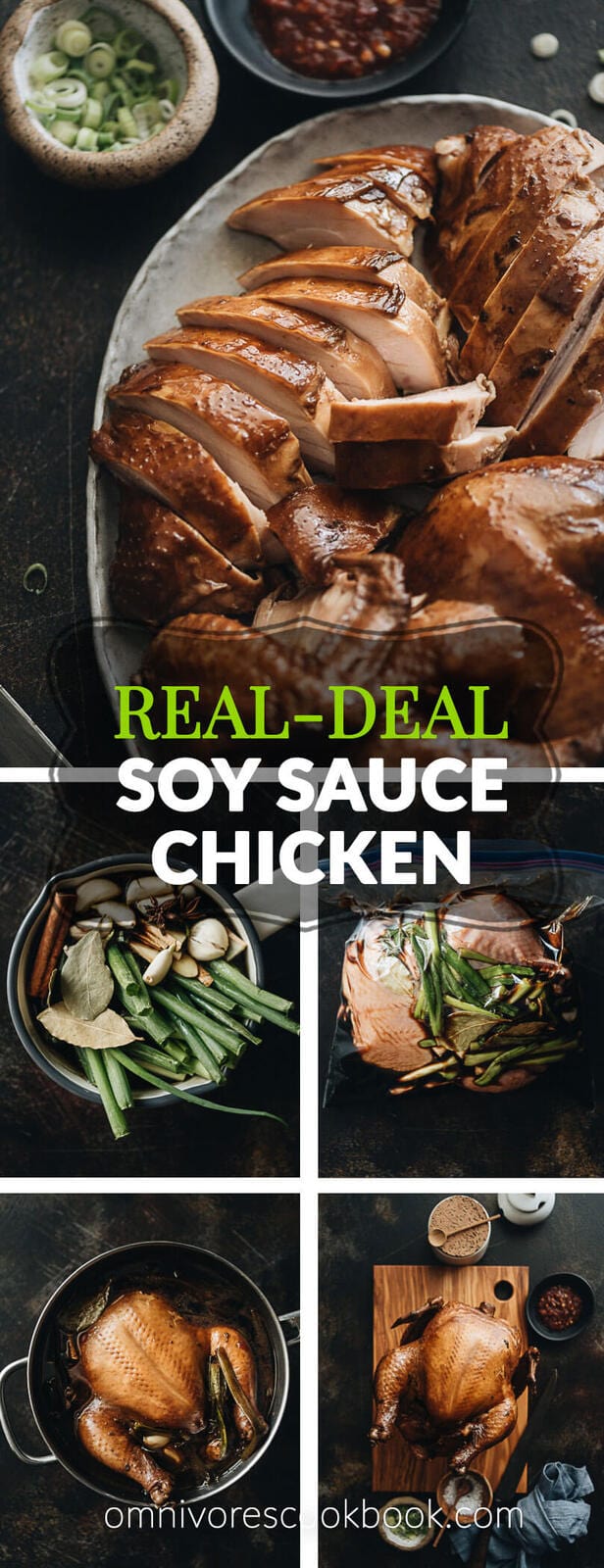

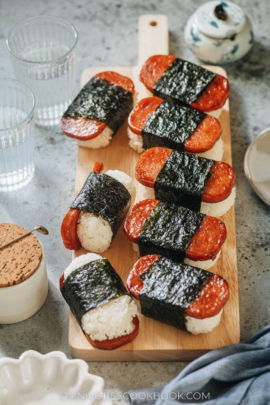
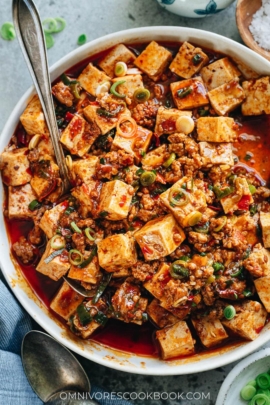

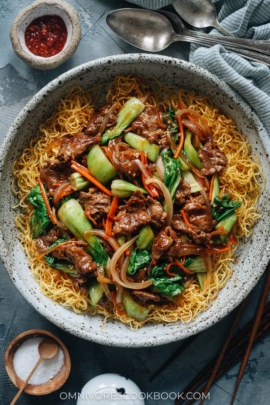
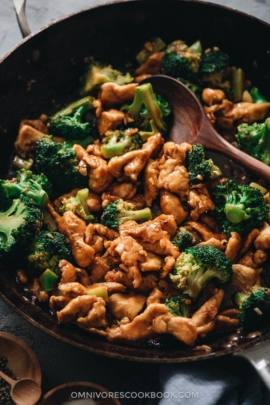
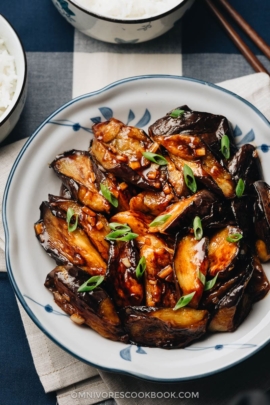






I made this last night and it is sooo delicious. Better than the restaurants! I used one of my own small home grown chickens. Thanks for a great recipe Maggie!
I need this chicken in my life. It sounds so amazing. I can’t wait to give it a try. I’ve never cooked a chicken this way (I always roast), so I’m excited to learn a new method!
I was at the Tastemaker conference last week and was hoping to meet you but never got the chance!
It’s really easy to source small chickens that weigh less than 2 pounds where I live. If I use a small chicken, should I just skip the marinade and halve the recipe?
Hi Andy, if you use a very small chicken you can marinate the chicken at room temperature for 30 minutes to 1 hour. I still prefer to marinate for just a while so the chicken is more flavorful. If you have a small pot that can just hold the chicken, then yes, you can halve the marinade. In terms of cooking time, you probably only need to simmer for 10 to 15 minutes. Check it doneness and steam it covered for a while if needed.
Thank you for your response! I’m used to exact recipes including temperatures (simmer is somewhere between 90C and 100C) and weights. Here’s how I did it:
– The chicken I used weighed exactly 2 pounds, so half of the original recipe.
– I used exactly the same recipe of liquid as stated, since I figured whatever leftovers I might have could be used as a sauce.
– I marinated the chicken for 6 hours.
– I didn’t have small narrow pot so I used a medium narrow stainless steel saucepan (5 quarts), which by diameter was barely large enough for the chicken.
– I noticed that the chicken was floating as I dropped it in, so I used a Japanese adjustable otoshi-buta to keep the chicken submerged, so I didn’t have to worry about any part of the chicken peeking out.
– I kept the chicken somewhere between a gentle simmer (90C) and a full rolling boil (100C) for 20 minutes.
– At this point the measured internal temperature of the thigh was around 60C, so not quite enough (instrument in question was a Thermapen).
– After that I removed the drop lid, put the saucepan lid on and let the chicken rest in the cooking liquid for 12 minutes, removing it from the heat source.
– After that I measured the temperature again, and now it was 75C measured at the thigh.
– I carefully removed the chicken from the liquid to a ceramic bowl and drained the liquid through a sieve to another bowl.
– I measured there was about 1 quart of liquid so I got 2x 0,5 quart plastic vessels to store the liquid.
– The first plastic vessel toppled over, spilling about 1 cup of liquid all over the stove and kitchen floor. I must’ve used every curse word known to mankind and my girlfriend angrily closed the bedroom door.
– I cleaned up the kitchen, salvaged the remaining liquid successfully and am now waiting for the chicken to cool down for carving. I already took a small bite though, and it’s absolutely sensational.
Absolutely delicious
Maggie can this chicken be cooked in a clay (terra cotta) dish? You know the ones that must be soaked in water before using.
Pretty sure you can use a clay pot as long as the pot is big enough to fit the chicken!
Maggie, does the chicken need to be completely submerged in the sauce? I’ve done the recipe, it was delicious but I have to say the skin wasn’t looking like yours, the skin was coming off and it wasn’t overcooked, I don’t understand why it happened.
Any advice for next time?
Thanks x
Hi Catarina, I’m thinking maybe the skin comes off because it got stuck to the bottom of the pot during the simmering? One thing I usually do is to gently move the chicken around using a spatula when the broth is heating up, so it won’t stick to the bottom of the pot. The skin got very fragile when it’s cooked, so you do need to pay extra attention when flipping it during the cooking and when you remove it from the pot. What I did was using a rubber spatula and my rubber oven cushion to move the chicken from the pot when it’s ready.
It’ll be ideal to submerge the chicken in the sauce, but it’s quite hard to achieve unless you use a pot that fits perfectly. When I cooked mine, maybe 1/4 to 1/3 of the chicken is not submerged and it didn’t cause any issue.
I don’t have any fennel seed. Will it still come out good? Anything I can substitute?
Thanks!!!
Hi Bryan, you can skip the fennel seed, or replace it with cumin (ground or whole cumin seeds). Happy cooking!
My mother in law recently passed away and my husband was reminiscing about her soy sauce chicken, for which we didn’t have a recipe, just memories. I found your recipe and we made it and it was like a piece of the past for him. So good! Thank you! Seriously. So good!
Great recipe, works well and perfect balance of flavours. The chicken was moist and tender, the sauce just perfect. I didn’t have time to marinate it – i simmered it straightaway in the marinade. 1.8kg chicken. I added less than a cup of water to bring it to a level to just cover the chicken. Sauce was still perfect.
Hi Maggie thank you for this great recipe. I recently tried a different recipe but it didn’t work out in that the chicken, whilst flavoursome, was unappealing as it had no colour to it. I was pleased to have found your recipe so have just cooked this dish. Very pleased with the chicken which had good colour, was moist and so tender. The family was impressed with this attempt!
So happy to hear you like the recipe! Thanks for letting me know 🙂
Can I use Mirin instead of the Shaoxing wine? Because there is none available here in Kuwait
Yes, you can use Mirin to replace Shaoxing wine. Happy cooking!
HI Maggie,
Sorry if this is a rudimentary question:
2 cloves
What are the 2 cloves?
Thanks,
Andrew
Hi Andrew, it is the spice whole dried clove: https://en.wikipedia.org/wiki/Clove
If you cannot find the whole clove, you can use a pinch of the ground clove as well.
Dear Maggie, I just made this recipe and gotta say that I was expecting really lovely chinese flavours as a result; but it didn’t work out, it tasted kinda like mole dulce (which is very bizarre).
I and also got to confess that I didn’t use a good soy sauce, neither did I use the especified cooking wine; I used sake.
Could you assist me so I can give it another try?
Thanks in advance.
Hi Marco, could you tell me what type of soy sauce you used? And yeah, sake taste much milder and slightly sweet than Shaoxing wine, which will produce a different result.
Loved it! My family used to make this growing up and I really loved this version. We cut back on the sugar to 1/4 c rock sugar, but it tasted delicious nonetheless.
Followed recipe as described with 3 1/4 lb chicken and substituted in dry sherry. I added some water to get fill line over meat of legs. Didn’t get any reduction of sauce after cooking or the tighter skin as shown in pictures, would love input on how that’s achieved. Besides that, this was a show stopper. First attempt at a recipe to have this reaction… everyone loved it from my three year old, my picky brother and my mother who usually only eats a small plate (She went for second). This will be in the rotation, thank you!
Served warm with bok choy and Japanese rice
What would you do with left over stock? It’s so yummy but there’s just so much. I only added just 2 cups of water.
Hi Kirby, you can use the leftover stock to make many things
– You can use it for braising meat or vegetables. For example, for vegetables like green beans, potato, radish and napa cabbage, it will be very delicious to braise the veggies in the broth.
– Make noodle soup: you can use the stock diluted with chicken broth or water (according to the saltiness) to make noodle broth. Boil some noodles and veggies, add to the broth and maybe top with an egg.
– You can use it to marinate meat and eggs (boiled and peeled).
This was one of the best meals I have ever ever made. Followed the recipe exactly and it came out looking almost identical to the picture. The flavor and tenderness are out of this world. Definitely will be making again and often. Thanks so much for sharing Maggie!
Do you flip the chicken during cooking? I didn’t see that written in the instructions and wasn’t sure if that was intentional so that you don’t overcook the white meat?
I don’t flip the chicken during cooking to make sure the white meat stays tender. Even it’s slightly above the broth, the meat will be cooked through by the steam eventually and result in a juicy texture while the dark meat cooked through on the bottom.
Hi there Maggie! I love your recipes! I was just wondering what sort of cooking time I should be looking at if I replace the whole bird with 2 lbs of boneless chicken quarters ? I live in Japan and getting whole chickens are a bit difficult.
Not sure how large is your chicken quarters, but I think low simmer 15 mins plus resting 30 minutes rest will do the job. If you’re worried the chicken will be under cooked, you can try simmer 20 mins and resting 20 mins.
What is 2 clove in the marinade? Thanks
It’s two pieces of the spice clove: https://www.healthline.com/nutrition/benefits-of-cloves
When I was a kid my much older sister had a Chinese boyfriend. They used to take me on picnics (as a chaperone?) and he always used to take a cold chicken. I loved it! Took me over 60 years to find out what it actually was and how to cook it. Seems a shame to waste the stock, so I strain it, pour into a 2 litre soft drink bottle, and put in the freezer for next time. There’s always a next time and when it comes around, I check the seasoning and add whatever it needs, in addition to the garlic, ginger, etc.
Hi Maggie,
I tried this recipe and the sauce was delicious. I had a smaller near 2 lbs chicken so I took one of the other comments you made to reduce the cooking to 10-15 mins. I went to 15 mins but let the chicken sit in the sauce for 30 mins after turning off the heat. The chicken was a bit drier than I would have liked and the internal temperature was 170. I’d really like to try this again because the taste was fantastic but wanted to ask whether you’d recommend reducing the cooking time or the sit in the pot time. What would you recommend?
BTW, the sauce is so good, we saved it to marinate eggs. Mm
I think you should definitely reduce the sitting in the pot time because it’s a bit harder to control. It’s the best to monitor the temperature and take out the chicken as soon as the temperature of the thickest part of the thigh reaches 165 F.
I’m glad to hear you like the sauce! You can use it as a noodle sauce as well. It’s really good drizzle with a bit chili oil 🙂
Had a whole chicken to cook for dinner and came across your recipe. So doable compared to the many Si Yau Kai (soy chicken) recipes I scrolled through – no honey!
I only used 1/2 cup sugar as one cup seems a lot (also only had castor sugar in the house) but everything else according to the recipe. Marinated for about three hours. The method of cooking is similar to one of my favorite hainanese chicken rice recipe(chicken goes into boiling water, 30 minutes simmering and 30 minutes rest), so I know the chicken will be tender when done.
The thighs were not fully submerged (despite 4 cups of water)so I suspected they could be undercooked. I was right but that was easily rectified by submerging the thighs again in the simmering liquid. Overall the chicken turned out so yummy and the meat was so tender. Slightly salty, probably due to the reduced amount of sugar.
Will certainly give it another go 😋. Thanks Maggie for the lovely detailed recipe and helpful hints
I’ve been researching this recipe and have read or watched about 15 instructions. Yours is the first to advise marinating – Kudos. I don’t see how you can get enough infused flavor without marinating. My only objection, if you can even call it that, is you are not frying the aromatics in the beginning, just pouring sauce in pot to heat. I don’t have your experience, but would like to know if you think frying the aromatics is a waste of time and effort? This is pretty traditional in Chinese cooking.
Frying aromatics definitely help building flavor more, although many traditional Chinese recipes boil the spices directly when it comes to braising. In this case, I think you can definitely fry the aromatics.
Actually the traditional recipe usually does not include marinating I think. the trick is to use super young and small chicken that has a very thin layer of meat (very hard to come by in the US), so you can infuse quite a bit flavor during the cooking. Plus, since it’s a street / restaurant dish, the chicken is usually left in the broth after cooking so it gets marinated more. For home cooking, I found marinating first will get you the most flavor using a regular size chicken.
We just had this for dinner tonight and it was AWESOME! I loved the overnight marinating step, such a good idea that imparts so much flavor into this chicken.
I made some minor changes: 1) pan fried all the aromatics before boiling up the sauce 2) I used palm sugar 3) I used 1.5 cups of soy sauce and 1 tbs of sesame oil 4) 1/2 tsp of cinnamon powder instead of a stick 5)no fennel seeds.
My chicken was close to 5lb and it fit snugly into my 4 qt pot. I was able to marinate and cook the chicken in that pot, and only needed to add 2 cups of water.
I plan to make this for future family gatherings. Thank you for such a fantastic recipe!
This Dish was so nice Maggie.The sauces were so delicious as had the other night.Thank you Maggie.
Really excited to try this recipe! We don’t have any authentic Chinese places around and I’ve missed soy sauce chicken! Some places serve the chicken cold with a ginger sauce that is really good, but I am clueless on how to make the ginger sauce. Do you have any good recipes for that? (Or even know what I’m talking about? Maybe I am mixing up dishes)
I love to serve the chicken with a bit sweet soy sauce mixed with regular soy sauce. And some hot sauce (chili garlic sauce or sriracha).
I think I know the ginger sauce you’re talking about. The base should be rice vinegar (or white vinegar) with grated ginger, a very small touch of garlic, pinch of salt and some sugar to balance it out.
Depending on the restaurant sometimes it has minced cilantro mixed in it, but it’s not a must. Don’t have a recipe now but I’ll look into it.